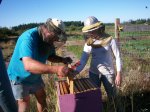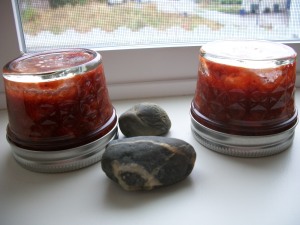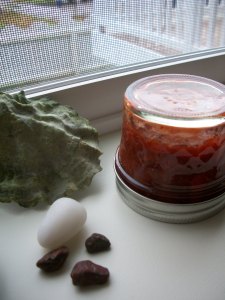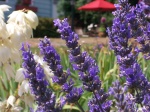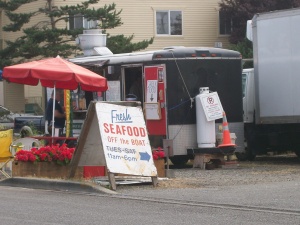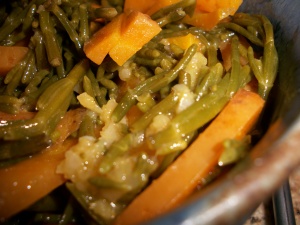
My family loves seafood. My father especially. Loves shrimp, scallops, any kind of fish, crab meat, lobster, and he really likes to compare clam chowders (vastly different dishes from New England to the Outer Banks.) One of his favorite restaurant’s in town is so because they have all-you-can-eat oyster specials on Monday and Tuesday nights. He also loves to fish and spend time at the family’s new beach house on Ocracoke Island.
Growing up, I remember not really liking the meals we had that consisted of shrimp and scallops at home. And I didn’t really like the crab legs I would order at Joe’s Crab Shack or any of the other generic something-or-other-Bay seafood restaurants that were a favorite for Sunday lunches after church got out. I really just went for the hushpuppies and the fun plastic bib and shell-crackers. It wasn’t until I was about 10 or 11 years old that I realized the reason I didn’t like those meals was because I have an allergy to shellfish. They make my mouth and throat itch incessantly for the rest of the day and night. I don’t break out in hives and my passageways don’t close up on me, my mouth just annoyingly itches and I take to clicking my tongue in a way against the roof of my mouth that renders it similar to hard plastic by the end of the day.
I remember it took my Dad awhile to accept this. He loves to share food and fellowship over food. He loves being able to share things and common interests with my sister and me and I remember him asking if I didn’t just want to try some of his shrimp, or try a bite of the crab cake. But once I finally sat down and explained to him that I thought I might be allergic to a component in the shellfish – iodine perhaps – and that it bothered my mouth every time, he accepted it.
It must have been an even harder blow a few years later when I declared I would never, ever eat fish again. On a trip to Ocracoke he had caught some flounder and prepared it at the house for us for supper. After 2 bites my mouth was filled with tiny little shards of jagged (if pliable) fish bones and I was completely taken aback and disgusted. At that point in my life I must have been used to Long John Silver’s fish platters (where for me it was more about the cracklins of breadcrumbs at the bottom of the kid’s meal bag) or something. *Important note: to my memory my mother never served us those horror of horrors called Frozen Fish Sticks. Thank you, Mother.
So for a few years I went without eating any seafood whatsoever. It must have been about the time that I became a vegetarian and donned fish an appropriate protein alternative, namely the very trendy wild caught Alaskan salmon that I began thinking of ordering fish again. And it must have been about that time that my family discovered sushi. My dad had been frequenting sushi restaurants some when he would go on business trips, and for heaven’s sake Asheville has some amazing sushi establishments. It was even a place my sister (one of the world’s pickiest eaters) consented to going – now she’s a sashimi fiend. My mom isn’t terribly fond of sushi itself, but she can usually find a nice rice dish or pad Thai for her meal. But above all, the thing my dad and I like most is the seaweed salad that’s offered on the appetizer menu.
I’ve never heard of my dad having food cravings, he doesn’t have an unusually large or active sweet tooth, he likes his meat and he’s been known to put away some good amounts of salt ‘n buttered popcorn. But when dad wants seaweed salad, our family’s going out for sushi.
It’s a wonderful blend of sour, sweet, salty, green and meaty. The fusion of rice vinegar, a tad pinch of sugar, some sesame seeds and the natural salty bitterness of the streaks of wakame itself (the most common type used in seaweed salads) lends itself to a deeply satisfying – if deeply stuck in between your teeth – dish. I’ve made recipes of it at home, and they’ve been good, but we still prefer to go to a restaurant to get our seaweed salad fix. It’s a great, healthy, tasty food item we can share together. Many of my date nights with my father have been to the various sushi restaurants around town.
So I’m sure my dad would be very interested to hear about the latest wild forage on my travels. Walking down the farmer’s market street last foggy, Saturday morning I came across what looked like branched-out horsetail sitting in a display basket. When I inquired, the vendor told me it was Samphire, or more appropriately, Salicornia virginica; sea asparagus. It’s wild-harvested off the coast of Vancouver Island, BC and in the surrounding waters (aka, here in Puget Sound.) I bought about 1/4 lb worth (about 2 grabs of the hand) to take home and try my hand at it.

Market purchases. The Samphire is between the loaf of bread and the sweet corn
It’s a thick, vibrant green seaweed with stalks about 4 inches long and 1/4 inch thick in diameter, hence the tributary name to its landlocked cousin. I’m told by the ether behind my laptop screen that it’s normally served in ‘fine dining establishments as an alternative to green vegetables, either fresh or sautéed.’ Also, that it pairs well with butter and garlic (um, what doesn’t?) Nonetheless, Dad, this is not your normal seaweed salad.
It keeps well in the fridge for up to 2 weeks, I had it stored in the crisper for about 4 days before I pulled it out and plopped it into the steamer basket and let it go for about 20 minutes; it’s awfully salty and this is recommended in all the recipes I found for it. Next I matchstick-ed some carrots and tossed them into the basket for about 8 minutes so they could get softened up a bit and meanwhile whipped up a dressing consisting of Dijon mustard, some rice vinegar, a HUGE clove of (local) garlic, some Bragg’s Amino Acids, a dollop of honey and some olive oil. This I spooned over the (rinsed) seaweed and carrots in a bowl and immediately put the bowl into the fridge to chill the salad.
It was a great, meaty textured side dish and the only things I would have done differently were using not quite so large of a clove of garlic, and adding some toasted sesame seeds to the veggies. And with nary a sliver stuck between my teeth.
Now, how to get northwest Samphire seaweed to a southeast seafood aficionado of a father?
 Chickens come in all shapes, sizes, colors, purposes and breeds. Why shouldn’t their homes? This is the chicken coop that I built as a personal project while here at Spring Rain Farm and Orchard. Though most onlookers have commented on the “hoop house,” it’s actually a light-weight chicken tractor, sans wheels.
Chickens come in all shapes, sizes, colors, purposes and breeds. Why shouldn’t their homes? This is the chicken coop that I built as a personal project while here at Spring Rain Farm and Orchard. Though most onlookers have commented on the “hoop house,” it’s actually a light-weight chicken tractor, sans wheels.  It mimics two other chicken coops they have on the farm that are moved about in the apple orchard; this one is actually tall enough that you don’t have to crawl through it to enter. It has no bottom, is easily moved by 2 or 3 people and will hop around the pasture every week or two as the birds peck, scratch and fertilize the footprint of the coop at each move. John, the farmer, has been more than helpful offering me his guidance, patience and carpentry knowledge every step of the way. So here I present to you, my first farm building project!
It mimics two other chicken coops they have on the farm that are moved about in the apple orchard; this one is actually tall enough that you don’t have to crawl through it to enter. It has no bottom, is easily moved by 2 or 3 people and will hop around the pasture every week or two as the birds peck, scratch and fertilize the footprint of the coop at each move. John, the farmer, has been more than helpful offering me his guidance, patience and carpentry knowledge every step of the way. So here I present to you, my first farm building project!
 bolts. These bolts proved to be the most time-consuming effort of the whole project as the thread was rusting and tightening the nuts down the length of the bolt was a process only as fast as the arch of a hand wrench could leverage – an arch impeded by tight corners, other screws and the low situation to the ground. To these side boards we screwed in and clamped
bolts. These bolts proved to be the most time-consuming effort of the whole project as the thread was rusting and tightening the nuts down the length of the bolt was a process only as fast as the arch of a hand wrench could leverage – an arch impeded by tight corners, other screws and the low situation to the ground. To these side boards we screwed in and clamped  eight 1- 1/2 thick PVC pipes bent over 2 top-supporting boards, also connecting the end walls.
eight 1- 1/2 thick PVC pipes bent over 2 top-supporting boards, also connecting the end walls.











